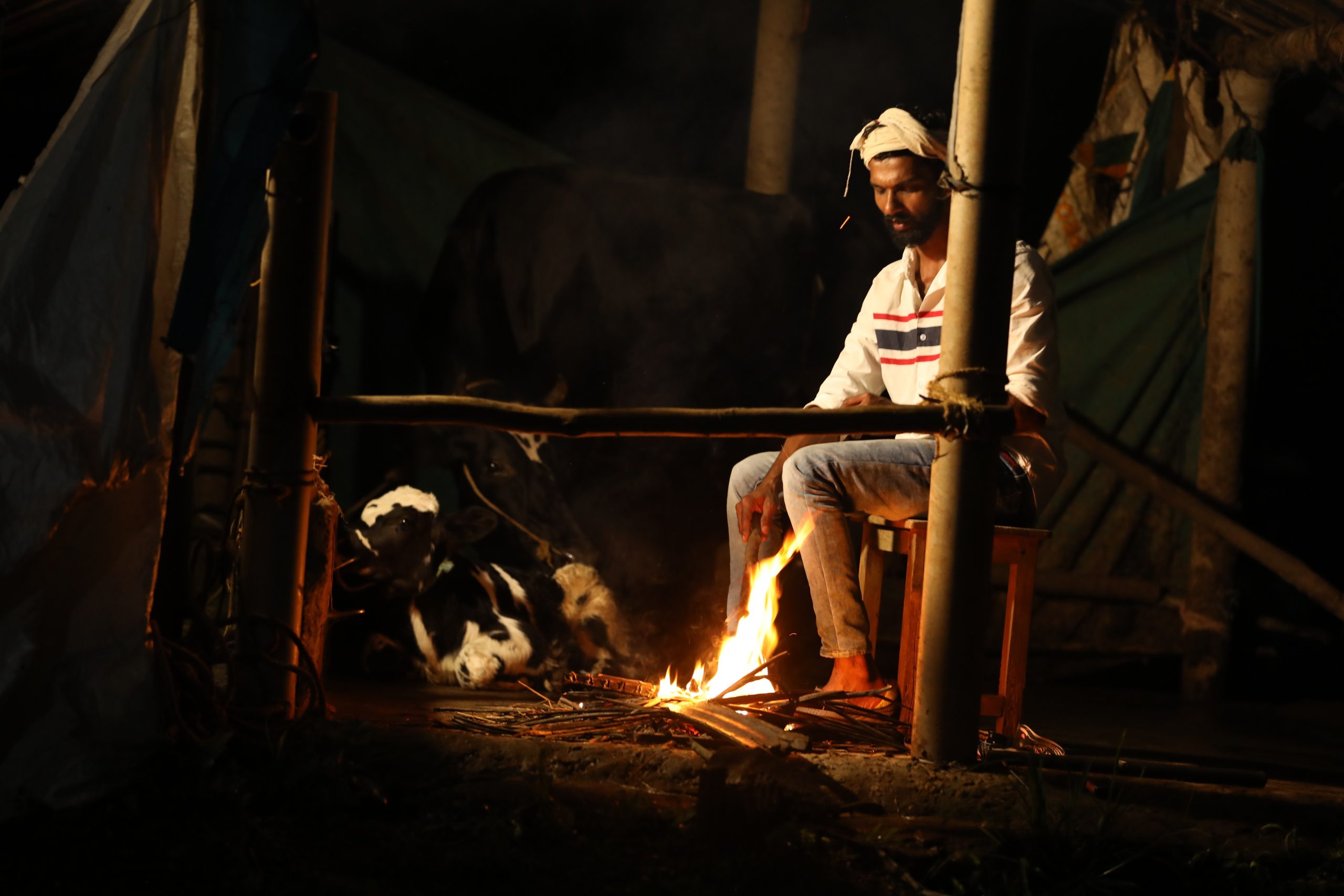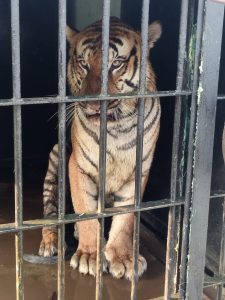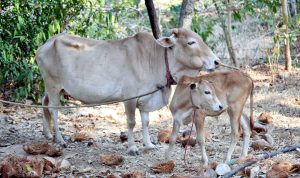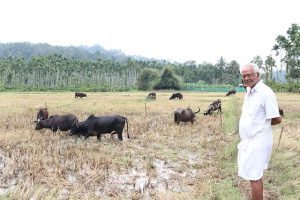South First traversed Wayanad to get a grip on a recent phenomenon — tigers entering villages to target cattle and humans.

M Jose, a cattle farmer of Mundakkolli near Cheeral in Wayanad guards his cow at night against tiger attack. (Jithesh Cheeral)
Kerala’s Wayanad, one of the favourite destinations of tourists, charms all with its mystic beauty, presenting different hues of green as the day progresses. The moon shines through the treetops at night, drawing patterns on the ground, giving a surreal experience.
A calmness punctuated by the chirps of crickets pervades the plateau as the night progresses. As tourists slip into sleep in posh resorts and homestays, KV Sasi of Cheeral village reaches for his flashlight and walks into the deceptive tranquillity of Wayanad’s darkness.
It has become a routine for him — to guard his cattle against sabre-toothed predators that strike at regular intervals.
Sasi looked exhausted when South First met him on a narrow road leading to the Wayanad-Ooty interstate highway near his village recently.
“I have been sleeping during the day, and staying awake throughout the night for the past 15 weeks,” he said wearily.
Unknown to tourists, Sasi’s routine reflects the truth that has been haunting this picturesque landscape in the northeast Kerala district, which the state government hard sells as the Green Paradise on the tourism circuit.
Bhaskaran, Baburaj, forest watcher Basavan, Jadayan and Shivakumar have one similarity in death. Their lives were cut short unexpectedly with a bone-chilling growl.
From Baburaj, 62, to Shivakumar, 24, all five lost their lives to man-eating tigers in as many years in Wayanad. One woman was killed across the border in Tamil Nadu as well.
The sexagenarian was killed while passing through a forested area to a neighbouring village from his Noolpuzha residence in 2015. The younger man was collecting firewood when the predator pounced on him in 2020.
Bhaskaran’s partially eaten body was recovered; rescuers who searched for Shiva found only his head. The tiger that ate Bhaskaran was later killed in Tamil Nadu after it had mauled a tea-estate worker, Mahalakshmi, three days after devouring the older man.
“I am a cow vigilante but of a different kind,” Sasi declared, ostensibly to distance himself from vigilantism that often turns violent over eating habits.
Sasi, a Congress worker who had actively campaigned for Rahul Gandhi during the 2019 Lok Sabha election, is a nominal cattle farmer.
Hailing from a tribal family, he opted to rear cows years ago when a local cooperative bank sanctioned him a loan to buy two high milk-yielding varieties and to construct a concrete shed for them.
According to an official estimate, the state has about four lakh tribespeople, and almost half of them are in interior Wayanad, the 12th district formed on 1 November, 1980.
The original inhabitants, or Adivasis, belong to Paniyas, Kurumas, Adiyars, Kurichiyas, Ooralis, Kattunaikkans and Uraali Kurumas tribes.
In Cheeral and its neighbouring villages like Nambiarkunnu, Pazhoor, Thaloor, Chulliyode, Madakkara, Mundakkolli, Noolpuzha and Kozhuvana, several farmhands and nominal farmers like Sasi, have switched over to rearing cows.
Their decision to take up tending to cattle did not go wrong. The milk fetched better prices from the local cooperative society, ensuring them a decent life and steady income — but one which could dry up anytime.
An eerie feeling gripped this correspondent while travelling the interior parts of the district. Fear and a sense of uncertainty were palpable in everyone South First met. Most of them are marginal farmers rearing cattle.
For the past five years, however, their chosen profession and cows have become a liability for them, as in the case of Sasi, who is forced to stay awake through the night to guard his cattle.
The cattle farmers feel they and their cows are the prime targets of a set of tigers, prowling the human habitations. The big striped cats have strayed into the villages from the forests of the UNESCO-designated Nilgiri Biosphere Reserve, spread over Kerala, Tamil Nadu and Karnataka.
“Don’t wander afar,” Sasi cautioned. “If they don’t get cows, they will target humans,” he warned.
South First spoke to several people who have been rendered helpless after their livestock fell prey to hungry tigers that struck silently under the cover of darkness. They, too, are now staying awake to protect their cattle from the prowling tigers.
“Don’t go to the interiors alone,” one of them echoed Sasi’s warning. “They (tigers) could be lurking in the coffee and pepper plantations.”
The warning kept playing in my mind, as if in a loop.
A loud, angry roar that woke up Pazhoor village around 3.30 am on 28 October denoted the accomplishment of a 26-day mission.

The tiger that killed 14 cows in Cheeral and its surroundings was captured on 28 October. (Pratheesh Cheeral)
Sasi and several others like him were temporarily relieved to know that the Forest Department officials had succeeded in trapping a 10-year-old tiger.
The big cat was one of the tigers that had been killing cattle and spreading terror in the area for the past several months. The capture was the culmination of a 26-day-long effort.
Before being trapped, the male predator had attacked a bait kept in the cage. Barely an hour earlier, the same tiger had killed a calf after entering a cowshed at Pazhoor. The calf belonged to a poor family that reared cattle for a living.
Families belonging to the low-income group, comprising tribespeople, Dalits and settlers from outside the district, form the population of Cheeral and its neighbouring areas.
The sense of relief Sasi others felt after the cattle-killer was trapped, however, was short-lived when another tiger struck within days.
The trapped tiger had killed 14 heads of cattle and grievously injured three others at Cheeral and neighbouring areas.
Though it had been captured, the scare of tigers still gripped the village and adjoining areas, Krishnagiri, Pulpally, Vadakkanadu, Kartikulam, Bavali, Chekadi, Tholpetty and Thirunelli.
“We are relieved to hear about the capture. But a lasting solution seems distant. Tigers have been straying into our villages regularly for more than the past five years,” Sasi said.
“They are giving us sleepless nights. Our women and children are forced to remain indoors. Even during the day, we move around only in groups,” said Sasi, his words reflecting the constant fear the villagers are forced to live with.
“People don’t go unarmed to plantations and paddy fields. They carry sticks and machetes with them,” the man said.
Sasi added that wild animals could attack at any time. “A single capture and relocation must be treated as a partial solution,” he said.
CPI(M) worker M Unnikrishnan was at a milk collection centre near Pazhoor early one morning when South First caught up with him. He works with a local cooperative of milk producers in Noolpuzha and is a cow vigilante.
“Don’t mistake me for north Indian vigilantes who target meat eaters. I eat beef. And I engage in political activity after working hours,” he introduced himself.
I don’t have any livestock at home, but I am part of the volunteers who move around to scare the tigers away. For most people in Sulthan Bathery and Mananthavady taluks, life is a constant battle with prowling tigers and marauding wild elephants,” Unnikrishnan presented a picture of life in the forest fringes of Wayanad.
Spread over 324 square kilometres, the Wayanad Wildlife Sanctuary (WWS) is not a tiger reserve. It is, however, contiguous to the tiger reserves of Nagarhole and Bandipur in Karnataka, and Mudumalai in Tamil Nadu.
Forest officials said the tiger population in WWS is 172, more than double of the officially declared collective population of Kerala’s Periyar and Parambikulam reserves. Parambikulam has 28 tigers, and Periyar, 40.
Tigers are solitary, territorial animals. A male tiger needs approximately 60 to 100 sq kms of contiguous forested area, while a female may need up to 20 sq kms.
Though WWS is contagious to Nagarhole, Mudumalai and Bandipur national parks with a sizeable tiger population, its topography and pleasant climatic conditions prompt most tigers to dwell in the sanctuary.
While the neighbouring sanctuaries face drought during peak summer months, Wayanad is an exception. Wayanad is also linked to the Silent Valley, BR Hills and Sathyamangalam forest regions. Such a contagious forest makes it the favourite place for tigers.
The forest also had enough prey for them till recently. But with some invasive plant species disrupting the food chain, herbivores shifted to other parts.
“In recent years, invasive plants have affected the biodiversity of all these forests, and thereby affecting the prey. As the food cycle got affected, tigers are now roaming the human settlements, looking for easy prey like cows, goats and poultry,” wildlife veterinarian Dr Anil Zachariah told South First.
“There are several aged tigers in Wayanad region and they find it easier to target livestock than the prey available in the forests,” he added.
Dr Zachariah also cited forest fragmentation, change in land-use patterns, climate change-related issues and human interference as reasons for the escalating human-wildlife conflict.
Ex-serviceman KM Daniel was fighting depression when South First visited him at his residence in Pulpally. He had bought some cows using his retirement benefits. Three of them fell prey to tigers.

The compensation awarded to farmers does not cover the total loss. (Representational photo/Creative Commons)
“Tigers prefer early mornings and they strike in unexpected areas. We reach the cattle sheds to milk the cows only after 6 am. It is shocking to see the partially eaten carcass of the cow that we are supposed to milk,” he said.
“Cows are our livelihood. The government is duty-bound to compensate us properly. We are now getting peanuts,” Daniel rued.
After each kill, revenue officials visit the scene and declare a meagre amount as compensation. There is no fixed amount or protocol to compensate the farmers. Additionally, the payment will not cover the total loss. Experts and farmers have demanded that the government consider the cost of the cow in the open market and compensate the owner accordingly.
Daniel said the tigers mostly target cows, but occasionally prefer goats and poultry.
Rearing cows is the only job Saritha Jaison of Karuvally knows. A tiger had killed her cow three weeks ago. Now, forest officials have told her that buying another cow is not viable.
“How do I manage the family? My parents are ailing. The government provided us loans under different schemes to buy cows and to grow fodders. Now, we need direction,” a confused and concerned Saritha said.
“My husband used to take milk to the society’s collection point daily at 5.30 am. My children and I had no option other than to pray to the Almighty to keep him safe as he walked alone through the darkness to the collection point,” she told South First.
“The fear of tigers has affected our morale as well. I stopped sending my children to their tuition classes. Muslim children in our area even stopped attending the madrassa in the mornings,” she added.
Saritha was outside the forest office at Thottamoola to file a fresh application for compensation when South First met her.
IC Balakrishnan, the MLA representing Sulthan Bathery was at the District Committee Office in Kalpetta. Speaking to South First, he said tigers started straying into human habitats over the past five years.

Congress MLA IC Balakrishnan felt climate change-related food-chain disruption might be a reason for the animals straying into human habitations. (Kerala Tourism)
“Earlier, crop-raiding wild elephants were the major problem,” he said.
“The tigers look famished,” the Congress legislator continued. “The food-chain disruption inside the forests due to climate change might have pushed them into human habitats.”
“Tigers are a threat to humans. There are other issues too. Monkeys, deer, wild boar, and elephants raiding crops are common across the district. They leave the farmers frustrated. The farmers are already reeling under the plummeting prices of cash crops such as coffee, pepper, cardamom, and areca nut,” he added.
KR Sajan, chairman of the People’s Protest Committee at Cheeral, felt the government’s pro-wildlife tilt is also complicating the matter.
“We are not against protecting animals. But our safety is equally important. Is sequestering themselves indoors an option for a predominantly agrarian community? How can we send our children to school? How can we engage in farming without being attacked by tigers,” he asked.
Sajan has two cows, and they have survived, as he puts it, only because of Providence.
There is a general feeling that government initiatives are for wildlife and not for the people. Restrictions imposed after the WWS was declared in 1973 have created the feeling.
Rumours, some manufactured with vested interests, have often forced people to rise in protest. About two years ago, hundreds of people took out a massive rally in Sulthan Bathery, demanding the government issue licences to hunt down the tigers, their main enemy.
According to a local politician, KJ Devasia, the farmers have doubts that the Forest Department brought tigers to Wayanad from elsewhere to put the local community under pressure and to declare WWS as a tiger reserve.
“We have serious doubts. I haven’t heard of tiger attacks during my childhood. Now it is widely prevalent. They must have brought in tigers from elsewhere. You don’t know the Forest Department well,” he said.
Wildlife Warden in Wayanad, K Abdul Azeez, objected to the propaganda that the Forest Department was ignoring the local communities.

Farmer Krishnan Chetty with his livestock in the forest fringe village of Chettiyalathur in Wayanad. (KA Shaji/South First)
“The Forest Department offices in Wayanad, too, are understaffed, besides facing a shortage of funds, as is the case elsewhere in the state. Practically, there is no easy solution for the man-animal conflict in the district,” he pointed out.
The officer briefly explained the problems leading to the conflict.
“Climate change and the spread of invasive species have ruined the forests. Since Wayanad is contiguous to Nagarhole, Bandipur and Mudumalai tiger reserves, the animals in the Nilgiri Biosphere crisscross the states searching for prey,” he told South First.
Azeez recommended a coordinated approach by the three states for a solution to the present situation. Currently, the states are acting independently. Destroying invasive species, planting fruit-bearing trees, undertaking eco-restoration activities and promoting the increase of normal prey of predators need joint action.
Experts suggested a single project covering the sanctuaries in the three states.
“People of Wayanad are suffering as tigers from the poorly conserved forest areas of Karnataka and Tamil Nadu reach here through the contagious green terrains without bothering about the geographical and political boundaries,” the forest officer said.
“Forest officials are risking their lives to protect the people, livestock and farm produce from wild animals,” he added.
According to KS Deepa, chief conservator of forests (north zone), the state government is preparing a comprehensive conflict mitigation plan for Wayanad. “But it will take time,” she said.
“We are seeking expert views from across India and outside. A final action plan would be drawn up as early as possible. It would be the best in the world,” she told South First.
Dr TV Sajeev, a scientist with Kerala Forest Research Centre at Peechi in Thrissur said efforts are on to study how other countries have addressed similar situations. “More expert opinions are solicited, besides learning case studies,” he said.
The chairman of the Wayanad Action Committee to Prevent Wildlife Attacks, TC Joseph, found fault with the Forest Department for not evolving long-term solutions.
“Once they trap a tiger or elephant, a huge celebration follows. People would then feel safe. Within weeks, similar attacks would occur in other parts of the district. The government’s priority should be to ensure people’s safety,” he said.
Environmentalists, however, felt an inclusive approach is the only way forward.
“Animals are an inseparable part of Wayanad’s fragile ecology,” said N Badusha, president of the Wayanad Prakrithi Samrakshana Samithy, a non-profit organisation.
The greens are not opposing a long-term solution, but they want the government to respect Wayanad’s stature as an environmental hotspot.
“Since the district is linked to most of the tiger reserves in Kerala, Tamil Nadu and Karnataka, the Union government is also responsible for alleviating the sufferings of the local community,” the environmentalist added.
Besides farmers, environmentalists, too, agree that the compensation provided for killed livestock is meagre. There is no fixed amount, and the farmers get lesser amounts based on recommendations made by village officers. The compensation provided is insufficient for the affected family to seek an alternative livelihood.
“The government must compensate for the actual loss. Nothing is wrong if the affected parties are awarded more money. But they are more often offered peanuts” Badusha said.
Successive state governments had tried several initiatives, including digging trenches, setting up power and rail fences, and constructing rock walls on the fringes of forests. Still, animals keep visiting human habitations.

Indiscriminate tourism and real estate ventures have changed the land use patterns of Wayanad. (Supplied)
Sajeev said Wayanad is one of the few remaining true wildernesses in the country. As much as 30 percent of the forests are virgin and unoccupied, with a rich biodiversity.
He favoured sustainable measures that can do justice to both humans and animals. “Wayanad’s agricultural economy is largely linked to the surrounding forest wealth. So, conservation and safety of humans must go hand-in-hand,” he said.
In recent years, indiscriminate tourism and real estate ventures have changed the land use patterns of Wayanad — yet another contributor to the increased human-animal conflicts.
“Climate change is affecting Wayanad severely. Smallholders are selling their degraded agricultural land to real estate investors and those promoting the tourism industry. Over the past two decades, debts have driven hundreds of farmers in Wayanad to suicide. Fluctuating prices of cash crops, especially paddy, pepper, ginger and coffee had pushed them over the brink,” J Devika of the Centre for Development Studies in Thiruvananthapuram, said.
“Untimely rains, rising heat, vanishing mist, disappearing birds and animals, and dying rivers have made the situation extremely bad. Both people and animals are bearing its brunt,” the social scientist, who has extensively studied the hill district, added.
Forest Department watchers, too, are feeling the heat of human-animal conflict. “People often blame us for their sufferings. Tracking animals involves locating raiding elephants and tigers that threaten human settlements,” VP Vinod, a watcher said.
The watchers risk their lives chasing the animals away. “We often feel we are doing a thankless job,” he added.
According to official statistics, 48 people were killed in human-animal conflicts in Wayanad in the past five years. As many as 532 livestock casualties, too, have been reported during the same period.
In the face of recurring tiger attacks, some experts recommended declaring WWS as a tiger reserve and relocating those residing on the forest fringes to safer places.
They opined that such a measure will safeguard the animals and minimise man-animal conflict, besides providing a security net for locals and helping them avail better compensation in case of casualties.
The proposal, however, ran into stiff resistance from locals, who feel insecure about rebuilding life in a different locality with inadequate financial compensation.
People said the tigers are targeting villages even far away from the forests, and the proposal of relocation is being made without a reality check.
“Over a dozen forest villages in Wayanad were relocated recently under a central government scheme. But the relocation packages were very meagre,” Sajan of the Cheeral People’s Protest Committee, said.
Relocating the tribespeople poses a challenge to their livelihood. “Kattunaykan tribes traditionally gather honey from forests. They will lose their livelihood once relocated,” he pointed out.
Those who agreed to shift after accepting ₹10 lakh as compensation found the amount meagre when they tried to buy land outside. Only those with false illusions are mooting the relocation of the residents,” he added.
According to farmers’ leader PT John, no scientific study has been undertaken so far on why tigers are straying out of the forests and targeting the livelihood of local communities.
“The situation is relatively new, and no such conflicts were reported 10 years ago. We need to know what is happening inside the forest environment to find a lasting solution,” he opined.
In the face of mounting criticism about its functioning, the Forest Department has started a Hospice and Palliative Care Unit for the big cats at Pachadi near Sultan Bathery. With the latest catch, the unit now has three tigers. The others, too, were trapped for killing cows but are aged.
“We are yet to decide on releasing the recently captured tiger at an isolated area deep inside the forest. As the other two are very old, we will not release them into the forests. In the case of the latest, sentiments of the local community also would be considered,” Azeez said.

Jul 26, 2024

Jul 26, 2024

Jul 26, 2024

Jul 25, 2024

Jul 25, 2024

Jul 25, 2024